


Summary. 21 cm: observations are reported for the galaxy NGC 7331. Maps with angular resolution of 25" × 45" are presented. The 21 cm continuum radiation extends over the bright optical disk (~ 7' in diameter). The HI distribution extends much farther out and is warped in the outer parts. The radial velocity field indicates that NGC 7331 has a complex warp: the bright optical disk is warped in one direction and the outer HI disk is warped in the opposite direction. The agreement between the warp inferred from the kinematics and the one directly seen in the HI distribution suggests that tilted ring models are an adequate description of warps.
The galaxy NGC 7331 is a well known spiral of type SA(s)bc (De Vaucouleurs et al., 1976). The presence of an outer dust lane enabled De Vaucouleurs (1958) to show that the spiral arms in this galaxy are wound counter to the direction of rotation. Sandage (1961) has described this galaxy in the Hubble Atlas. The spiral structure can be traced inwards to about 6" from the nucleus. Nevertheless, on deep photographs, such as taken by Arp and Kormendy (1972), a very prominent bulge appears. The size of this galaxy is 13.5' × 7.0' in the system of Holmberg (1958). At 30' southwest of NGC 7331 there is the well know group of galaxies called Stephan's Quintet.
This galaxy has been the subject of a variety of studies. Lindblad (1941) and Kalloghlian (1962) obtained photometry of the inner parts. Rubin et al. (1965) measured radial velocities of HII regions and were able to derive a rotation curve for the inner 120". Roberts (1968) measured its integral HI profile. Arp and Kormendy (1972) called attention to faint optical emission in between NGC 7331 and Stephan's Quintet.
In this paper we will describe 21-cm HI line observations of this galaxy, obtained with the Westerbork Synthesis Radio Telescope (WSRT). Originally this galaxy has been observed with the WSRT by Bajaja, who obtained data at irregularly distributed hour angles. Unfortunately the processing of such, data is rather cumbersome and the results, though interesting, were not very reliable. Renewed interest in higher quality data for this galaxy arose after a number of other galaxies appeared to have warped HI disks. Edge-on galaxies showed their warp directly in the HI' distribution (Sancisi, 1976), while for less inclined galaxies like NGC 5055 and NGC 2841 (Bosma, 1978) the warp is inferred from the velocity field. Because NGC 7331 has a rather high inclination (~ 70° or more) we thought it worthwhile to see whether this galaxy is warped. First we obtained low resolution data; these showed that a warp is indeed present. Thereafter we obtained high resolution data (25" × 45") which enabled us to see whether the HI warp seen directly corresponds with the warp expected from the kinematics. In this way a clear link has been established between warps inferred from the kinematics and direct warps.
We will describe the observations in section 2 and present the results in section 3. In section 4 we present a warp model and discuss the radial distribution of various quantities in this galaxy.
2. Observations and data processing
The observations have been made with the WSRT and its 80-channel
filterspectrometer
(Allen et al., 1974).
Data have been recorded
at twenty antenna spacings, ranging from 36 m to 1404 m in steps of
72 m, for the full period of 12 hours. This leads to a synthesized
beamwidth of 25.2" × 44.9" at halfpower points and first grating
responses at
10' × 18'( ×
×
 ). To cover the range
of radial velocities
in the galaxy four settings of the local oscillator were necessary;
this provides 32 velocity channels ranging from heliocentric velocities
510 km s-1 to 1130 km s-1 in steps of 20 km
s-1. The filterwidth is 129 kHz, corresponding to a velocity
resolution of 27.2 km s-1.
Maps have been obtained by application of the standard WSRT procedures
for calibration and Fourier transformation
Högbom and Brouw,
1974).
The rms noise in one channel map is about 1.9 K.
). To cover the range
of radial velocities
in the galaxy four settings of the local oscillator were necessary;
this provides 32 velocity channels ranging from heliocentric velocities
510 km s-1 to 1130 km s-1 in steps of 20 km
s-1. The filterwidth is 129 kHz, corresponding to a velocity
resolution of 27.2 km s-1.
Maps have been obtained by application of the standard WSRT procedures
for calibration and Fourier transformation
Högbom and Brouw,
1974).
The rms noise in one channel map is about 1.9 K.
The channel maps contain both line and continuum radiation Since at most four channel maps are free of line radiation we could not remove the continuum radiation by averaging these four channels and subtracting this average, since this results in a serious degradation of the rms noise level of the maps. Instead, we have first subtracted the background point sources and their associated instrumental responses from all maps. Then we have subjected all channel maps to the procedure CLEAN (Högbom, 1974). The reasons for this are 1) the base level of the maps is not zero in the chosen interferometer configuration, 2) the sidelobes and grating responses in each channel map are disturbing when maps are going to be combined, and 3) we did not measure the 0-m spacing. As has been argued previously (Bosma, 1978) the procedure CLEAN solves these problems all at the same time. The cleaned channel maps have been processed further with the window method (Bosma, 1978); this resulted in 32 continuum-free line channel maps, a map of the 21 cm continuum, a map of the distribution of HI column densities, and a map of the radial velocity field. Although the declination of NGC 7331 is so low (34°) that we should expect in the maps small effects due to shadowing of the telescope dishes at the shortest spacing, we found that these effects were not noticeable (hence less than about 0.5 K).
We have checked our CLEAN results by constructing an integrated HI profile and comparing this profile with a 300 ft measurement by Shostak (1978). The agreement is very good in the central parts of the velocity range. At the turnover velocities the 300 ft signal is attenuated with respect to our data. This difference can be entirely reproduced if we correct our data for the primary beam of the 25 m elements and multiply the result with the 300 ft beam. We are therefore confident that we did not miss a significant amount of HI radiation in our cleaned maps.
In Fig. 1 we show the map of the 21 cm continuum radiation in NGC 7331, along with a short exposure photograph. This map shows great similarity to a previous 1415 MHz map obtained with the WSRT by Van der Kruit (1973). His map, however, is slightly contaminated by HI emission in the southern half of the galaxy which radiates at frequencies within the passband of the 1415 MHz continuum receiver. Note that NGC 7331 has a bright disk in the continuum, but no strong nuclear source. In another paper (Hummel and Bosma, 1978) we will present a 50 cm continuum map of NGC 7331 and discuss the spectral index distribution.
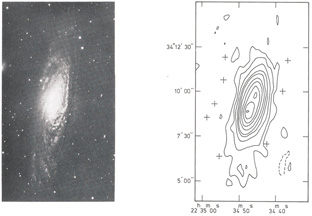 |
Figure 1. Photograph of NGC 7331 taken with the 200-inch telescope at Hale Observatories, b 21 cm continuum map of NGC 2841 at the same scale as the photograph. The contours are at -0.85 (dashed), 0.85, 1.7, 3.4, 5.1, 6.8 10.2, 13.6, 17.0 and 20.4 K. |
The channel maps containing line radiation are shown in Fig. 2 From these maps we can conclude already that NGC 7331 is not a disk galaxy with pure rotation. The emission is not symmetric with respect to the major axis: apparently the outer parts (r > 2.5') are deviating from the main plane.
In Fig. 3 we present the two channel maps at the velocity of turn-over of the rotation curve, smoothed to a resolution of 51" × 90", superimposed on a print of a IIIaJ plate, taken at the 4 m telescope at Kitt Peak by Dr. H.C. Arp and kindly made available by him. The outer parts of the HI distribution in these channel maps do not align with the optical disk; this is similar to what has been found for the edge-on galaxies NGC 5907 and NGC 4565 by Sancisi (1976).
In Fig. 4 we present the map of the HI column density distribution, corrected for the primary beam, superimposed on the IIIaJ print. The rms noise in this map is of course variable, due to the varying number of channels used in the summation; in most areas it is about 1.75 102 atoms cm-2. The dashed contour in Fig. 4 is the 5 × 1019 atoms cm-2 contour from the HI column density distribution at the resolution of 51" × 90".
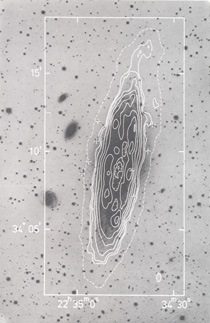 |
Figure 4. Map of the HI column density distribution in NGC 7331, superimposed on the IIIaJ print. The contours are 0.5 (dashed), 3.1, 6.2, 12.4, 18.6, 24.8, 31.0 and 37.2 1020 atoms cm-2. |
We note the following characteristics of the HI distribution in NGC 7331:
The extent of the HI emission is not much larger than that of the optical emission.
The inner contours of the HI distribution have an axial ratio of 4:1, while at the 26.6 magn. arcsec-2 level in the optical light the axial ratio is about 2:1.
There is a relative absence of HI emission in the central regions. The area over which this occurs is not centred on the nucleus but slightly to the south of it. It should be pointed out that a slight variation in the continuum level (the base level of the profiles at these points) can give rise to a substantial error in the HI column density here because the profiles are rather broad. This broadening is caused by the very rapid change of the rotation curve within one synthesized beam element.
The orientation of the HI distribution is changing
as function of
radius, but the effect is not large (only about 5°). We have
integrated the channel maps to obtain an integral HI profile.
From this profile we find, if we assume that the gas is optical
thin, a total HI mass of about 8.2 × 109
M . In this
calculation we
have adopted. a distance of 14 Mpc to NGC 7331, based on its systemic
velocity.and a Hubble constant of 75 km s-1 Mpc-1.
. In this
calculation we
have adopted. a distance of 14 Mpc to NGC 7331, based on its systemic
velocity.and a Hubble constant of 75 km s-1 Mpc-1.
The profiles at each point have a simple shape with one narrow peak, except for the central parts where they are broader. The accuracy of the intensity-weighted mean radial velocities at each point is better than 10 km s-1. In Fig. 5 we present the map of the radial velocity field, superimposed on the 4 m print. There are a few points noteworthy about this map:
There is an asymmetry between the northern and southern half of the galaxy.
The position angle of the major axis changes its orientation with radius. At the centre the position angle is about 167°, which corresponds to the position angle of the major axis of the radio continuum map. Then the position angle changes to a more north-south direction, while at the edge of the optical disk it turns back to a more east-west orientation. Such a complex behaviour has also been found for NGC 5055 (Bosma, 1978); there the amplitude of the changes is even much larger.
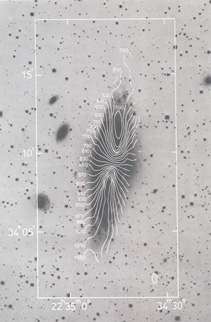 |
Figure 5. Map of the radial velocities in NGC 7331, superimposed on the IIIaJ print. The numbers indicate heliocentric velocities in km s-1. |
We have made maps with lower resolution, 51" × 90" and 2' × 3', and have inspected these for HI emission outside the galaxy that may correspond to faint optical emission seen on plates processed by Arp and Lorre (1976). No emission has been found above a level of 0.01 K. We conclude from this that there is no evidence in the HI distribution for a bridge or trail connecting Stephan's Quintet with NGC 7331. The faint optical features found by Arp and Lorre might be located in our Galaxy (cf. discussion by Sandage, 1976).
The HI distribution by itself indicates already that NGC 7331
has a warped HI disk. The radial velocity field has characteristics
similar to that of NGC 5055 for which we constructed a warp model
based on the kinematics. For NGC 7331 a warp model has been constructed
along the same lines. The procedure works as follows: we divide
the galaxy into concentric rings and allow each ring to have its own
orientation in the sky. As position of the centre we adopted the one
given by
Van der Kruit (1973):
 =
22h34m46.63s,
=
22h34m46.63s,
 = 34°09'22.0"
(1950.0). For each ring we specify a given set of orientation
parameters: position angle of the line of nodes,
= 34°09'22.0"
(1950.0). For each ring we specify a given set of orientation
parameters: position angle of the line of nodes,
 , and
inclination, i.
From the observations we determine the mean circular velocity,
Vc, in
that ring and the dispersion around that mean. As final values for
, and
inclination, i.
From the observations we determine the mean circular velocity,
Vc, in
that ring and the dispersion around that mean. As final values for
 ,
i and Vc we adopt those for which the
dispersion around the mean Vc
is a minimum. We have also computed the mean surface density of neutral
hydrogen,
,
i and Vc we adopt those for which the
dispersion around the mean Vc
is a minimum. We have also computed the mean surface density of neutral
hydrogen,
 H, for each
ring. In our calculations we have adopted
a systemic velocity of 820± 5 km s-1, based on the
symmetry in the inner parts of the galaxy.
H, for each
ring. In our calculations we have adopted
a systemic velocity of 820± 5 km s-1, based on the
symmetry in the inner parts of the galaxy.
We have made a model HI distribution and velocity field based on
the radial distributions derived with the procedure described above.
It turned out that the velocity field did not agree very well with
the observed one: the inclination of the galaxy is so high that the
intensity weighted mean radial velocity of a profile at a given point
is not anymore a proper measure of the projected circular velocity at
that point. A value of the radial velocity which differs more in
absolute value from the systemic velocity than the intensity weighted
mean is a better measure. Note that this problem arises because we
observe with a beam of 1.7 × 3.0 kpc in the plane of the sky, which
corresponds to roughly 6.6 × 3.0 kpc in the plane of the galaxy;
hence areas with different radial velocities occur in one beam. To
correct for this effect we have slightly adjusted the values of
 , and
i, and also a few values of Vc, to achieve a
better fit. In Fig. 6a-d
we show the resulting curves of
, and
i, and also a few values of Vc, to achieve a
better fit. In Fig. 6a-d
we show the resulting curves of
 (r),
i(r), Vc(r) and
(r),
i(r), Vc(r) and
 H(r),
and in
Fig. 7 we show the warp model based on these
curves. The agreement
with Figs. 4 and 5 is
only fair. The asymmetry between the northern
and the southern half of the galaxy makes it difficult to obtain a
much better fit, but minor improvements of the model are certainly
possible.
H(r),
and in
Fig. 7 we show the warp model based on these
curves. The agreement
with Figs. 4 and 5 is
only fair. The asymmetry between the northern
and the southern half of the galaxy makes it difficult to obtain a
much better fit, but minor improvements of the model are certainly
possible.
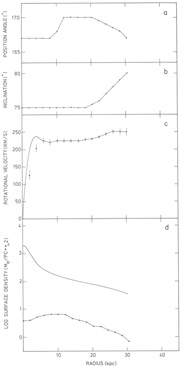 |
Figure 6. Radial distributions of the position angle of the major axis a, inclination b, rotation velocity c and surface densities of total mass and HI gas mass d (upper and lower respectively). |
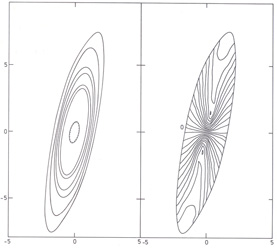 |
Figure 7. The HI contour shapes (left) and radial velocity field (right) resulting for the tilted ring model described in the text. The contour unit of the velocity map is 20 km s-1, the contour labeled 0 has been added, the other contours have the same label as in Fig. 5. |
The successful description of the warps inferred from the kinematics with a tilted ring model have now been achieved for a number of galaxies: M83 and M33 (Rogstad et al., 1974, 1976), M31 (Roberts and Whitehurst, 1975; Newton and Emerson, 1977), NGC 5033, NGC 5055, NGC 2841 and NGC 7331 (Bosma, 1978). Our results for NGC 7331, that is to say the consistency of the results of the kinematical model with the directly observed warp in the HI distribution (see Fig. 3), strengthens the argument that we are indeed dealing with warped disks rather than with disks which are planar but somehow have their gas flow in elliptical orbits instead of circular orbits. Moreover, similar calculations with the same type of tilted ring model for the edge-on galaxy NGC 5907 for which a warp has been found (Sancisi, 1976) can reproduce the observations rather well. We must emphasize, however, that the asymmetries present in the HI distribution and the velocity field, of all the galaxies listed above make the determination of a perfectly fitting symmetric model illusory.
A striking difference between NGC 7331 and some of the other warped galaxies is that the warp starts already at a distance of 0.5 times the Holmberg radius from the centre. In M83, NGC 5055 and NGC 2841 the warp starts at about 0.8 times the Holmberg radius. Inspection of Fig. 1a given the impression that the most prominent northern arm is tilted out of the plane, in the same direction as the warping indicated by the velocity field. In the outer parts the warp is at the opposite side of the plane. Perhaps warps are "organized" z-oscillations of the disk, or at least of the population I component in the disk at all radii, with the amplitude of the oscillations increasing outwards. Note that in our Galaxy even in the inner parts some minor ripples occur in the principal plane of the HI distribution (see Fig. 6 of Gum et al., 1960). It would be of interest to see whether the population II component of NGC 7331 is warped too.
Although NGC 7331 is warped, the amplitude of the warp is so
small that the rotation curve in Fig. 6c may be
a rather good indicator
of the mass distribution. We have calculated a mass model
with the thin disk method outlined by
Nordsieck (1973).
In the inner
parts, where the velocities are too low because of the beam smoothing,
we replaced the 21 cm points with data from
Rubin et al. (1965)
(the line in Fig. 6c was used as input rotation
curve). The total mass out to 30 kpc, Mo, is
3.1 × 1011
M , In
Fig. 6d we have
plotted, the curve of the mass surface density,
, In
Fig. 6d we have
plotted, the curve of the mass surface density,
 M(r). As
for NGC 5033, 3198,
5055 and 2841 we find that
M(r). As
for NGC 5033, 3198,
5055 and 2841 we find that
 M(r)
/
M(r)
/  H(r) in
the outer parts is roughly
constant. This phenomenon appears so frequently in the data that we
suspect it to be physically significant (see also
Bosma, 1978
chapter 7).
H(r) in
the outer parts is roughly
constant. This phenomenon appears so frequently in the data that we
suspect it to be physically significant (see also
Bosma, 1978
chapter 7).
We have derived a luminosity profile from the photometry of
Kalloghlian (1962).
The reliability of this photometry, which goes
out to about 3', is difficult to assess. Comparison with
 M(r)
yields a mass-to-blue-luminosity of about 6 in the inner parts. From
BTo = 9.51
(De Vaucouleurs et al.,
1976)
we find LB = 4.6 × 1010
L
M(r)
yields a mass-to-blue-luminosity of about 6 in the inner parts. From
BTo = 9.51
(De Vaucouleurs et al.,
1976)
we find LB = 4.6 × 1010
L . Thus
Mo / LB = 6.8, MHI
/ LB = 0.18 and
MHI / MT = 0.026. We also have
made a mass model fit with the models described by
Shu et al. (1971).
We find a total mass in the fit
Mt = 8.3 × 1011
M
. Thus
Mo / LB = 6.8, MHI
/ LB = 0.18 and
MHI / MT = 0.026. We also have
made a mass model fit with the models described by
Shu et al. (1971).
We find a total mass in the fit
Mt = 8.3 × 1011
M , hence
Mt / LB = 18.
This suggests that M / L might increase with radius; in
the outer parts it could be 50 or more.
, hence
Mt / LB = 18.
This suggests that M / L might increase with radius; in
the outer parts it could be 50 or more.
It might be objected that the mass in NGC 7331 is not distributed in a disk. Indeed, as pointed out in section 3, and also illustrated by the prints of 3 stacked IIIaJ plates (Arp and Kormendy, 1972), NGC 7331 has a large nuclear bulge. This bulge may or may not continue outwards into a dark halo. As already illustrated for NGC 2841 (Bosma, 1978), the mass models for a combined halo/disk galaxy have many parameters which are difficult to fix. We therefore did not attempt to construct such a mass model for NGC 7331.
NGC 7331 is similar in several respects to NGC 5055 and NGC 2841: we find a warped HI disk, the rotation curve remains rather flat, the M/L ratio seems to increase with radius, part of the mass could reside in a halo. Therefore we do not repeat here the discussion about the problem of the origin and maintenance of the warp. To that discussion (see Bosma, 1978) we might add that the warp in NGC 7331 strongly suggests that warps are oscillatory phenomena over the whole disk, perhaps in the low velocity dispersion component only, with the amplitude increasing outwards.
NGC 7331 seems to be the most massive member of a
small group of galaxies.
Lynds (1972)
has measured radial velocities of most of
the galaxies in the neighbourhood. On the basis of those data
Materne and Tammann
(1974),
among others, have argued that NGC 7331, NGC 7320
and two small irregular galaxies: A 213 and UGC 12060, form a group
projected onto a larger, more distant, group of galaxies at a redshift
around 6000-8000 km s-1. The low redshift member of
Stephan's Quintet, NGC 7320, lies only 30', or 120
kpc if we adopt a distance of 14 Mpc, southwest of NGC 7331. NGC 7320 has been mapped with the
WSRT by
Allen and Sullivan
(1977).
It does not appear to be disturbed
considerably, but the ratio radius/beamsize is about 1.5 and therefore
not much can be concluded from these data. The total mass of
NGC 7320 can be estimated from the integral HI
profile and is about 1.0 × 1010
M ,
(Shostak, 1978).
The two dwarf galaxies are probably even
less massive. It seems therefore unlikely that the warp in NGC 7331
is caused by tidal interaction.
,
(Shostak, 1978).
The two dwarf galaxies are probably even
less massive. It seems therefore unlikely that the warp in NGC 7331
is caused by tidal interaction.
Finally, we should comment on the asymmetries in the HI distribution and the velocity field. Not only do they restrain the construction of symmetric models to describe the observations, they also present a problem in their own right. They seem to call for an explanation with asymmetric conditions built-in. Tidal interaction could be one possibility if suitable companions are present; perhaps capture of HI clouds is another. In this respect the strange asymmetry 2.5' northwest of the nucleus of NGC 7331 is intriguing. The nature of these clouds is not so clear at the moment. Apparently they do not exist far away from galaxies (Shostak, 1977), but they have been discovered around other galaxies too (Wright, 1973; Davies, 1974; Mathewson et al., 1975, etc.).
From our 21 cm line observations of NGC 7331 we conclude:
The HI distribution in the outer parts deviates from the main plane, just as in NGC 5907.
The velocity field seems to indicate a complex warp: in the region between 2' and 5' radius the deviation from the main plane is opposite to the deviation in the very outer parts.
The agreement between the warp seen directly and the warp inferred from the kinematics implies that a description of warps in other non-edge-on galaxies in terms of tilted ring models is plausible.
The rotation curve derived for NGC 7331 remains flat in the outer parts. This may indicate the presence of a dark halo component in the mass distribution.
There is a depression in the HI surface density in the inner parts; in the outer parts the ratio total mass/HI gas mass surface density remains more or less constant.
In Table 1 we have collected a number of parameters of NGC 7331 derived in this study.
| Position (1950.0) |  =
22h34m46.63s, =
22h34m46.63s,
 = 34°09'22" = 34°09'22" |
| Size (Holmberg, 1958) | 13.5' × 7.0' |
| Adopted distance | 14 Mpc |
| Luminosity | 4.6 × 1010
L |
| HI mass | 8.2 × 109
M |
| Total mass, Mo, out to 30 kpc | 3.1 × 1011
M |
| MHI / Mo | 0.026 |
| MHI / LB | 0.18 |
| Mo / LB | 6.8 |